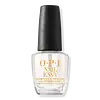What's inside
What's inside
 Key Ingredients
Key Ingredients

No key ingredients
 Benefits
Benefits

No benefits
 Concerns
Concerns

 Ingredients Side-by-side
Ingredients Side-by-side

Ethyl Acetate
PerfumingButyl Acetate
MaskingNitrocellulose
Alcohol Denat.
AntimicrobialSucrose Acetate Isobutyrate
Isopropyl Alcohol
SolventEthyl Tosylamide
Acrylates Copolymer
Adipic Acid/Neopentyl Glycol/Trimellitic Anhydride Copolymer
Etocrylene
UV AbsorberTosylamide/Epoxy Resin
Aleurites Moluccanus Seed Oil
Skin ConditioningTocopheryl Acetate
AntioxidantHydrolyzed Wheat Protein
Skin ConditioningAloe Barbadensis Leaf Extract
EmollientDimethicone
EmollientAscorbic Acid
AntioxidantCI 60725
Cosmetic ColorantEthyl Acetate, Butyl Acetate, Nitrocellulose, Alcohol Denat., Sucrose Acetate Isobutyrate, Isopropyl Alcohol, Ethyl Tosylamide, Acrylates Copolymer, Adipic Acid/Neopentyl Glycol/Trimellitic Anhydride Copolymer, Etocrylene, Tosylamide/Epoxy Resin, Aleurites Moluccanus Seed Oil, Tocopheryl Acetate, Hydrolyzed Wheat Protein, Aloe Barbadensis Leaf Extract, Dimethicone, Ascorbic Acid, CI 60725
Ingredients Explained
These ingredients are found in both products.
Ingredients higher up in an ingredient list are typically present in a larger amount.
Acrylates Copolymer is used as a film-forming agent and texture enhancer.
After applied, Acrylates Copolymer forms a thin film cover that helps skin feel more soft. It can help sunscreens become more water-resistant.
It is also used to make a product more thick.
Learn more about Acrylates CopolymerAlcohol Denat. is an alcohol with a denaturant property. It is created by mixing ethanol with other additives.
This ingredient gets a bad rep because it is irritating and drying - mostly due to its astringent property. Astringents draw out natural oils in tissue, constricting pores and leaving your skin dried out.
However, alcohol denat. is not all that bad.
Due to its low molecular weight, alcohol denat. tends to evaporate quickly. One study on pig skin found half of applied alcohol evaporated in 10 seconds and less than 3% stayed on skin.
This also helps other ingredients become better absorbed upon application.
Studies are conflicted about whether this ingredient causes skin dehydration. One study from 2005 found adding emollients to propanol-based sanitizer decreased skin dryness and irritation. Another study found irritation only occurs if your skin is already damaged.
Small amounts of alcohol are generally tolerated by oily skin or people who live in humid environments.
The rule of thumb is if this alcohol is near the end of an ingredients list, it will probably not affect your skin much.
Also...
This ingredient has antimicrobial and solvent properties.
The antimicrobial property helps preserve products and increase their shelf life. As a solvent, it helps dissolve other ingredients.
Other types of astringent alcohols include:
Learn more about Alcohol Denat.We don't have a description for Butyl Acetate yet.
This synthetic colorant is used to add a violet color to products. It is water-soluble.
Dimethicone is a type of synthetic silicone created from natural materials such as quartz.
What it does:
Dimethicone comes in different viscosities:
Depending on the viscosity, dimethicone has different properties.
Ingredients lists don't always show which type is used, so we recommend reaching out to the brand if you have questions about the viscosity.
This ingredient is unlikely to cause irritation because it does not get absorbed into skin. However, people with silicone allergies should be careful about using this ingredient.
Note: Dimethicone may contribute to pilling. This is because it is not oil or water soluble, so pilling may occur when layered with products. When mixed with heavy oils in a formula, the outcome is also quite greasy.
Learn more about DimethiconeEthyl Acetate is a fragrance.
We don't have a description for Etocrylene yet.